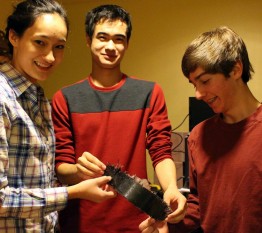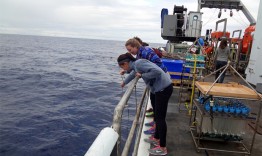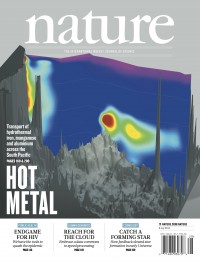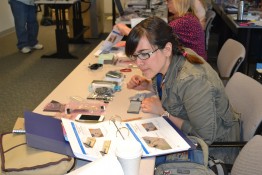At this year’s Marine Advanced Technology Education (MATE) International Competition in St. John, Newfoundland, three high schoolers from Seattle nabbed the top prize for their ocean-ready remote-controlled submersible, beating teams from Russia, China, and Canada to name a few. Mentored by UW oceanographers, the group—named AMNO & CO—competed against 33 teams from six countries, proving that even the smallest team in their division could come out on top.
Read more »College of the Environment students, researchers at sea to learn more about deep-sea volcano eruption
When the Axial Seamount, an underwater volcano, erupted off the coast of Oregon in April, researchers knew within minutes that something spectacular was happening more than 300 miles offshore. Precision hardware installed by the University of Washington last summer let scientists see its effects almost instantly from shore. A team of researchers, engineers and students is now at sea working to maintain that equipment and assess the volcano’s aftermath.
Read more at UW Today »JISAO, NOAA find that seafloor hot springs are significant source of ocean's iron
On the seafloor, volcanic and magmatic forces create hot springs that spew heated water into the depths of the ocean. Hot, acidic water scours metals from Earth’s crust, and these warm, chemical-rich waters support exotic deep-sea ecosystems. Historically, metals like iron and manganese were thought to quickly react and form particles that would clump together or stick to other things, causing them to sink to the seafloor.
Read more at UW Today »UW oceanographers wire up an undersea volcano to study Earth's most extreme environment
Several hundred miles off the coast of Oregon and Washington, there’s an undersea volcano known as Axial Seamount. Thanks to a set of high-tech instruments installed last summer by a team of scientists, many from the College of the Environment, the deep sea is online and oceanographers were able to observe an eruption of the Axial Volcano in April 2015. PBS NewsHour’s Hari Sreenivasan recently spoke with the School of Oceanography‘s John Delaney and Debbie Kelley about their team’s deep sea observatory, including a network of sensors, moorings, and cameras that collect troves of new information about this underwater world.
Read more at PBS NewsHour »UW scientists engage the next generation of oceanographers through STEM partnership
For nearly 40 Washington State teachers attending the Olympic STEM Pathways Partnership workshop at the University of Washington in late-June, it was like Christmas had come early. Each educator sifted through a toolkit full of techy gadgets—a breadboard, ribbon cables, wires, antennas, and a microprocessor. The teachers used their cache of materials to assemble a powerful, data-collecting underwater sensor; and over the next several years, they’ll develop an approach to bring their new expertise back into the classroom.
Read more »





